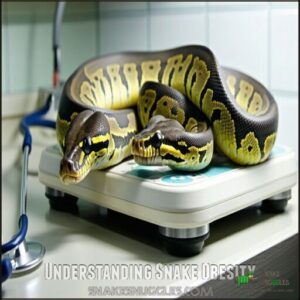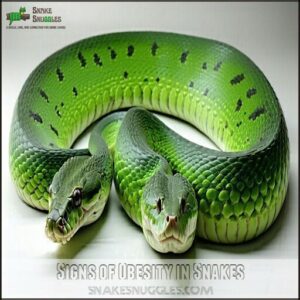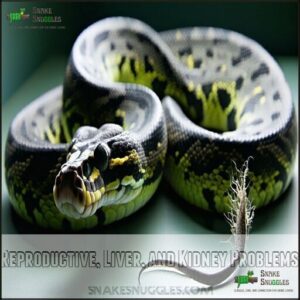This site is supported by our readers. We may earn a commission, at no cost to you, if you purchase through links.
 Yes, snakes can get fat. Your serpentine friend isn’t immune to obesity, though it looks different than in mammals.
Yes, snakes can get fat. Your serpentine friend isn’t immune to obesity, though it looks different than in mammals.
Overweight snakes show visible fat rolls along their bodies, reduced muscle tone, and a sluggish disposition. Unlike humans who carry fat primarily under skin, snakes store excess fat internally around organs.
This hidden obesity can lead to liver disease, reproductive issues, and shortened lifespan. You’ll need to monitor feeding schedules carefully—what seems like a healthy appetite might actually be overindulgence.
The good news? With proper diet adjustments and habitat enrichment, you can help your tubby reptile slim down and regain its sleek, sinuous form.
Table Of Contents
- Key Takeaways
- Understanding Snake Obesity
- Can Snakes Get Fat?
- Health Risks of Snake Obesity
- Causes and Prevention of Snake Obesity
- Treating and Managing Snake Obesity
- Frequently Asked Questions (FAQs)
- Why do Snakes get fat?
- Are snakes overweight?
- Do snakes gain weight?
- Is obesity bad for a snake?
- How do you know if a snake is overweight?
- Are snakes underweight?
- Why do snakes gain weight?
- Is it unhealthy for a snake to be overweight?
- What are signs that a corn snake is overweight?
- Can a snake be underweight?
- Conclusion
Key Takeaways
- You can identify an overweight snake by looking for visible fat rolls, scale spreading, a squishy body texture, and a rounded back where the spine isn’t visible.
- Unlike mammals, snakes store excess fat internally around their organs, making obesity harder to detect and potentially more dangerous to their health.
- Your snake’s obesity can lead to serious health problems including cardiovascular strain, liver disease, reproductive issues, and a shortened lifespan.
- You’ll prevent snake obesity by controlling portion sizes, reducing feeding frequency, providing adequate enclosure space, and creating opportunities for exercise and enrichment.
Understanding Snake Obesity
Snakes can store fat inside their bodies to use as energy during times without food, but too much fat can be dangerous.
Fat is a snake’s survival strategy, but excess becomes a silent predator lurking within their coils.
Understanding how obesity affects your snake helps you spot problems early and keep them healthy.
How Snakes Store Fat
Did you know snakes store fat differently than mammals? Instead of subcutaneous fat, they rely on internal fat storage for survival.
Their fat bodies, located in the back third of the coelom, act as primary energy reserves. The liver also plays a key role, storing and mobilizing fat when needed.
Seasonal variation impacts fat distribution, with wild snakes building reserves for lean periods.
- Quick fact: Fat reserves adapt to each species’ needs, highlighting remarkable differences in snake anatomy and metabolism.
In captivity, limited activity can disrupt this balance, emphasizing the importance of proper husbandry practices.
Internal Fat Deposition in Reptiles
Snakes store fat in sneaky places—mainly as visceral fat within their bodies.
This visceral fat distribution makes spotting reptile obesity harder. Unlike mammals with subcutaneous stores, snakes hide fat reserves around organs, called organ encasement, impacting their metabolic health.
Species variation adds complexity; each snake’s fat accumulation differs. Without clear signs like external rolls, undetected obesity can sneak up, leading to severe health problems.
A high-fat diet is a predisposing factor in reptile obesity. Monitoring weight helps you manage snake fat effectively.
Can Snakes Get Fat?
Yes, snakes can get fat, especially in captivity when they’re overfed or kept in small enclosures.
Overfeeding, lack of exercise, and improper husbandry are the main reasons for unhealthy weight gain.
Signs of Obesity in Snakes
Spotting snake obesity isn’t tricky if you know what to look for.
A squishy body texture and scale spacing are big giveaways, often paired with love handles or a rounded back where the spinal bulge vanishes.
If your snake has a stretched, sticky post-meal look or feels like a stress ball, you could be dealing with an overweight snake.
Keep their snake body condition in check!
Rapid weight loss attempts can be risky, and the snake diet promotes extreme calorie restriction.
Differentiating Obesity From Healthy Weight and Pregnancy
You’ve spotted scale spread and worry it signals trouble—but is it an overweight snake or pregnancy?
Pregnancy feels firm due to eggs, while snake obesity shows squishy fat rolls.
Scale appearance, body texture, and weight patterns help identify problems.
Keep an eye out for signs like:
- Coelomic firmness vs. squishy fat deposits
- Bulging spine or uneven body condition
- Visible fat folds in an “S” shape
Understanding species variation guarantees your snake’s healthy weight and best care!
Health Risks of Snake Obesity
Excess fat in snakes can strain their hearts, lungs, and other organs, leading to serious health problems. It can also cause liver damage, kidney issues, and complications with reproduction.
Cardiovascular and Respiratory Issues
An overweight snake doesn’t just carry extra weight—it carries hidden risks.
Heart strain leads to poor blood flow, affecting organ oxygenation.
Excess fat compresses the lungs, causing breathing difficulties that limit activity and worsen snake health.
These cardiovascular and respiratory issues can turn a lively pet into a lethargic, struggling creature.
Left unchecked, snake obesity slowly burdens essential organs, making even simple movements feel like a marathon.
Keep weight in check for a healthier snake.
Reproductive, Liver, and Kidney Problems
A heavy snake doesn’t just struggle to move—it faces internal chaos.
Obesity triggers reproductive blockers like follicular stasis, while fatty liver quietly disrupts metabolism.
Kidney damage adds to the danger, as pressure-packed organs scream for relief.
Watch for signs like sluggishness and swelling; unchecked organ strain leads to metabolic damage, liver disease, and cutting into a snake’s health span.
Regular shedding issues can also be a sign of illness; be sure to check for scales coming loose.
Causes and Prevention of Snake Obesity
Snake obesity often happens because of overfeeding and lack of exercise. You can prevent this by feeding the right amount, offering suitable enclosures, and encouraging movement.
Overfeeding and Inactivity
Too much food and too little exercise can lead to snake obesity, especially in captivity. Overfeeding disrupts their metabolism, creating an obesity cycle.
Stick to portion control by using feeding charts. Using a proper feeding schedule can prevent overfeeding.
Offering exercise outside their enclosure can combat inactivity. High-calorie meals, like oversized rodents, should be avoided.
| Cause | Impact | Solution |
|---|---|---|
| Overfeeding | Metabolic impact | Use portion control |
| Inactivity | Weight gain | Increase exercise needs |
| Large prey items | Excess body fat | Adjust snake diet |
| Small enclosure | Limited movement | Provide enrichment space |
Inadequate Enclosure and Environmental Factors
A cramped snake enclosure size can turn your active pet into a couch potato.
Small spaces and poor setups harm snake wellbeing, limiting exercise and promoting obesity.
Watch out for these issues:
- Tiny enclosures restrict movement and natural behaviors.
- Missing temperature gradients slow metabolism.
- No climbing or hiding opportunities reduce activity.
- Shallow substrate depth limits digging.
Fix these to encourage snake exercise, reduce stress, and keep your snake environment stimulating and healthy.
Maintaining proper husbandry can help in preventing snake obesity.
Treating and Managing Snake Obesity
You can help your snake lose weight by adjusting its diet and encouraging more movement.
Small changes, like offering smaller prey and creating opportunities for exercise, can make a big difference.
Dietary Adjustments and Exercise
Getting your snake back on track starts with small, gradual changes to its diet. Adjust the feeding frequency and practice portion control by offering prey close to the snake’s widest point.
Encourage movement with enrichment activities, like climbing structures or supervised exploration. These exercise regimens improve overall snake weight management.
Providing adequate space in their enclosure also promotes activity. Proper snake nutrition, alongside hydration, keeps their metabolism in check, keeping your slithery friend healthier and happier.
Enrichment and Veterinary Care
A healthy snake thrives with proper care. Focus on enclosure enrichment—add climbing structures, safe hideouts, and scent-stimulating items to encourage movement.
For enhanced activity, consider various climbing options. Exercise importance can’t be overstated, so let your snake explore supervised areas.
Regular veterinary checkups guarantee the best reptile health and help identify early obesity signs. Follow personalized guidelines from a specialized vet to manage diet, hydration strategies, and overall snake health effectively.
Your efforts can make all the difference, emphasizing the need for proper care to ensure a healthy and thriving snake.
Frequently Asked Questions (FAQs)
Why do Snakes get fat?
Snakes get fat primarily from overfeeding in captivity.
You’ll see them develop squishy body texture, visible fat rolls, and stretched scales.
Their limited movement in small enclosures also contributes to weight gain, much like our own sedentary lifestyles.
Are snakes overweight?
Yes, captive snakes can become overweight.
You’ll notice stretched scales with visible skin underneath, squishy texture instead of firm muscle, and fat rolls when they bend.
Proper feeding schedules and enclosure size help prevent obesity.
Do snakes gain weight?
Your pet snake definitely can gain weight.
In captivity, they’ll pack on pounds from overfeeding, large prey items, or limited exercise space.
Fat deposits appear as "love handles" and squishy body texture.
Is obesity bad for a snake?
Like Charlie, my friend’s ball python who struggled to shed, obesity in snakes can cause heart problems, liver damage, and difficulty moving.
You’ll see shorter lifespans and reproductive issues in your overweight slithery pet.
How do you know if a snake is overweight?
You’ll notice an overweight snake has visible spaces between scales, feels squishy instead of firm, shows fat rolls when coiled, and may have a rounded back with a disappearing spine.
Are snakes underweight?
You’ll see underweight snakes showing protruding spine bones and visible ribs.
Your snake can be underweight from illness, parasites, stress, or improper feeding.
They’ll appear thinner than normal with a triangular-shaped body, which can be a clear sign of being underweight.
Why do snakes gain weight?
Your snake gains weight primarily from overfeeding.
Too many meals or prey that’s too large can cause obesity.
Lack of exercise in small enclosures also contributes by limiting movement and suppressing their metabolism.
Is it unhealthy for a snake to be overweight?
Just as a balloon stretched too thin risks popping, your overweight snake faces serious health hazards.
Obesity can cause cardiovascular strain, organ damage, respiratory issues, and a shortened lifespan.
You’ll need to adjust their diet immediately to mitigate these health hazards.
What are signs that a corn snake is overweight?
Your corn snake is overweight if you spot scales spreading apart, visible skin underneath, fat rolls when coiled, a squishy texture instead of firm muscles, and a rounded back where the spine isn’t visible.
Can a snake be underweight?
Yes, your snake can definitely be underweight.
You’ll notice a triangular body shape, visible spine, sunken sides, and loose skin.
It’s just as concerning as obesity and requires prompt dietary adjustments.
Conclusion
Ultimately, yes, snakes can get fat, and monitoring your pet’s body condition is essential for their longevity.
Like a telegram from your snake’s body, those subtle fat rolls signal it’s time to adjust feeding schedules.
You’ll need to balance proper nutrition with appropriate feeding frequency to maintain your serpent’s health.
Remember that prevention is easier than treatment.
With consistent care and regular vet check-ups, you’ll keep your slithery companion in prime shape for years to come.
- https://www.vetlexicon.com/exotis/reptiles/nutrition/articles/obesity/
- https://www.sciencedirect.com/topics/earth-and-planetary-sciences/adipose-tissue
- https://onlinelibrary.wiley.com/doi/am-pdf/10.1111/brv.12288
- https://www.researchgate.net/publication/304530700_The_physiology_of_lipid_storage_and_use_in_reptiles_Lipid_physiology_in_reptiles
- https://pubmed.ncbi.nlm.nih.gov/27348513/













